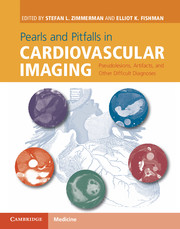 Pearls and Pitfalls in Cardiovascular Imaging
Pearls and Pitfalls in Cardiovascular Imaging from Section 4 - Coronary arteries
Published online by Cambridge University Press: 05 June 2015
Imaging description
Motion artifact in coronary CT angiography (CCTA) occurs when the temporal resolution of the acquisition is inadequate to resolve moving cardiac structures. A temporal resolution of < 50 msec is required to permit imaging of cardiac structures during any point in the cardiac cycle without blurring. Current scanner technology has not yet achieved this benchmark, and therefore imaging is targeted to portions of the cardiac cycle that have the least motion, mid-diastole (60–70% of R-R interval) and end-systole (30–40% of R-R interval). Motion artifacts can affect any vessel, but are most pronounced in the RCA, the vessel with the highest displace- ment velocity and range during the cardiac cycle. Motion artifacts may have one of several appearances. In some cases, low-attenuation blurring of the coronary artery lumen and wall may be seen, simulating segmental high-grade stenosis or occlusion (Figure 32.1). In other cases, arcs or rounded regions of high and low attenuation may be seen adjacent to the coronary arteries (Figure 32.1). Recognition of blurring of the walls of cardiac chambers, such as the left atrium or ventricle, can provide a clue that the images are degraded by motion and should be interpreted with caution (Figure 32.1). In the setting of elevated heart rates (> 70 beats per minute), reconstructed phases obtained in end-systole at approximately 30–40% of the R-R interval have the greatest chance of diagnostic images. For motion-degraded CCTA examinations, multiple reconstructed phases can often be used to piece together a comprehensive assessment of the coronary arteries. In this scenario, not all vessel segments will be best visualized on a single phase, but each segment is well visualized on at least one phase.
Importance
Motion blurring can simulate coronary artery stenosis. The motion leads to blurring of the coronary lumen and adjacent low-attenuation fat, resulting in an appearance mimicking high-grade stenosis. Reconstructed phases from different points in the cardiac cycle should be evaluated to confirm or disprove any significant coronary artery stenosis (Figure 32.2). Motion artifact is the major reason for non-diagnostic scans.
To save this book to your Kindle, first ensure [email protected] is added to your Approved Personal Document E-mail List under your Personal Document Settings on the Manage Your Content and Devices page of your Amazon account. Then enter the ‘name’ part of your Kindle email address below. Find out more about saving to your Kindle.
Note you can select to save to either the @free.kindle.com or @kindle.com variations. ‘@free.kindle.com’ emails are free but can only be saved to your device when it is connected to wi-fi. ‘@kindle.com’ emails can be delivered even when you are not connected to wi-fi, but note that service fees apply.
Find out more about the Kindle Personal Document Service.
To save content items to your account, please confirm that you agree to abide by our usage policies. If this is the first time you use this feature, you will be asked to authorise Cambridge Core to connect with your account. Find out more about saving content to Dropbox.
To save content items to your account, please confirm that you agree to abide by our usage policies. If this is the first time you use this feature, you will be asked to authorise Cambridge Core to connect with your account. Find out more about saving content to Google Drive.